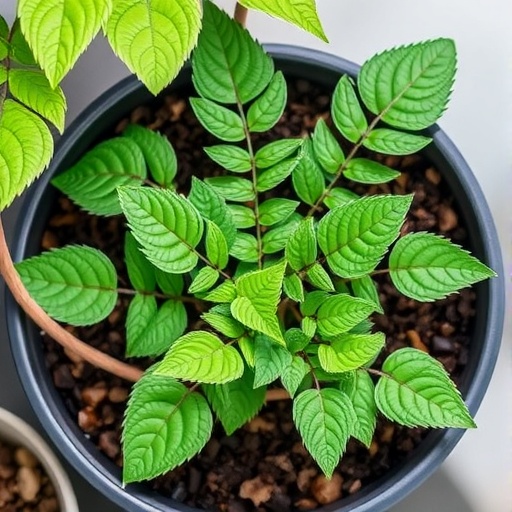In a groundbreaking study examining the multifaceted benefits of natural compounds, researchers have focused their attention on the ethanolic extract of Athyrium filix-femina, a perennial fern commonly known as lady fern. This botanical wonder has recently gained prominence not merely for its aesthetic appeal but for its promising phytochemical profile, which showcases a plethora of bioactive compounds. The recognition of its extensive applications in various domains, particularly in medicine and food preservation, establishes Athyrium filix-femina as a focal point in the exploration of herbal remedies.
A deeper dive into the study reveals that scientists have systematically evaluated the phytochemical components of the ethanolic extract from this fern species. The findings enumerate a wide array of chemical constituents that include flavonoids, tannins, alkaloids, and saponins, each known for their respective therapeutic benefits. The detailed profiling of these compounds sets the foundation for understanding how Athyrium filix-femina could potentially support health maintenance and disease prevention when integrated into dietary practices.
Antioxidant capacity is one of the pivotal areas where the research shines. The extraction process employed revealed that the ethanolic extract of lady fern exhibits significant antioxidant properties. By neutralizing free radicals, these antioxidants play a catalytic role in diminishing oxidative stress, a key contributor to various chronic diseases, including cardiovascular ailments and certain types of cancer. This intriguing interplay between dietary compounds and oxidative stress management underscores the importance of integrating such natural sources into our daily nutrition.
Moreover, the antimicrobial activity linked to the ethanolic extract of Athyrium filix-femina paves the way for potential applications in healthcare, especially in combating microbial infections that resist conventional antibiotics. The study indicates that this fern extract possesses the ability to inhibit the growth of bacteria and fungi, shedding light on a natural alternative to synthetic antimicrobial agents. As antibiotic resistance burgeons globally, such findings could revolutionize the approach to developing new antimicrobial formulations sourced from nature.
The researchers employed rigorous methodologies throughout their investigation, ensuring that the results are scientifically sound and replicable. Techniques such as colorimetric assays to determine antioxidant capacity and agar dilution methods for assessing antimicrobial efficacy were utilized. These methods not only strengthen the validity of the findings but also provide a blueprint for future studies aiming to explore other botanicals with potential health benefits.
In light of the international shift towards more sustainable and less chemically-dependent medical solutions, the phytochemical exploration of Athyrium filix-femina stands at the intersection of tradition and modernity. Indigenous cultures have long embraced the uses of various ferns for medicinal purposes, but contemporary scientific validation presents an opportunity to bridge folklore with empirical science. Such an integration could foster greater acceptance and usage of herbal remedies alongside conventional medical practices.
The excitement surrounding this fern extends to its implications in food science, where its antioxidant properties can be harnessed to enhance food preservation methods. In an era where food quality and safety are paramount, natural preservatives derived from plants offer a promising alternative to synthetic additives. The ability of lady fern’s extract to improve the shelf life of perishable goods while maintaining food safety is a compelling reason for the food industry to consider it an essential ingredient.
As the global community grapples with health challenges posed by lifestyle-related diseases, the discovery of beneficial compounds in everyday plants can be a game-changer. The holistic attributes of Athyrium filix-femina could stimulate research into dietary interventions that are not only nutritious but also therapeutic. This sends a clarion call for nutritionists and healthcare professionals to consider plants with medicinal properties in their health recommendations.
The relevance of this study extends beyond the immediate scientific community, as public awareness regarding the benefits of herbal extracts continues to rise. Educational initiatives aimed at promoting the understanding of phytochemicals present in common greenery could empower individuals to make informed dietary choices. Engaging the public in such discussions has the potential to elevate the role of plants like Athyrium filix-femina in health and wellness.
Furthermore, the environmental perspective is also a vital part of this conversation. Sustainable harvesting practices and ethical sourcing of medicinal plants are essential for preserving biodiversity. The potential commercialization of fern extracts must therefore be approached with caution, ensuring that the ecosystems from which these plants are drawn remain intact and renewable for future generations.
In summation, the advancement in understanding Athyrium filix-femina offers a fascinating glimpse into the prospective benefits of plant-derived compounds. The implications of this research are significant, not only for healthcare and environmental sustainability but also for cultural practices surrounding nutrition. As more studies unfold, a clearer picture of how such plants can contribute to human health and wellbeing is likely to emerge, shedding light on the age-old connection between nature and medicine. As we tread further into this realm of discovery, the potential for Athyrium filix-femina to transform nutritional practices and public health perspectives seems boundless.
In closing, this research emphasizes a crucial paradigm shift towards embracing the medicinal properties of plant-based extracts, highlighting the need for deeper exploration of flora that has long been overlooked in the context of modern healthcare. The synergy between science and nature encapsulated in this study may potentially be a guiding light as humanity seeks organic and effective solutions to contemporary health issues, reiterating once again that nature can indeed be our most profound ally in fostering health and healing.
Subject of Research: Ethanolic extract of Athyrium filix-femina
Article Title: Phytochemical profile, antioxidant capacity, and antimicrobial activity of Athyrium filix-femina ethanolic extract.
Article References:
Huynh, TTN., Vo, DHN., Nguyen, TT. et al. Phytochemical profile, antioxidant capacity, and antimicrobial activity of Athyrium filix-femina ethanolic extract.
Discov. Plants 2, 238 (2025). https://doi.org/10.1007/s44372-025-00324-y
Image Credits: AI Generated
DOI:
Keywords: antioxidants, Athyrium filix-femina, antimicrobial, phytochemicals, sustainable health.




